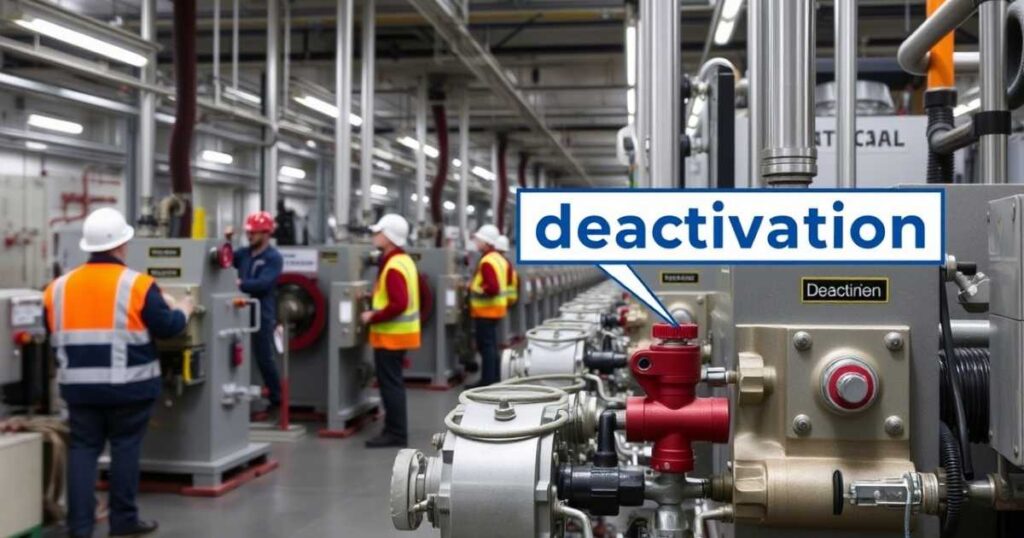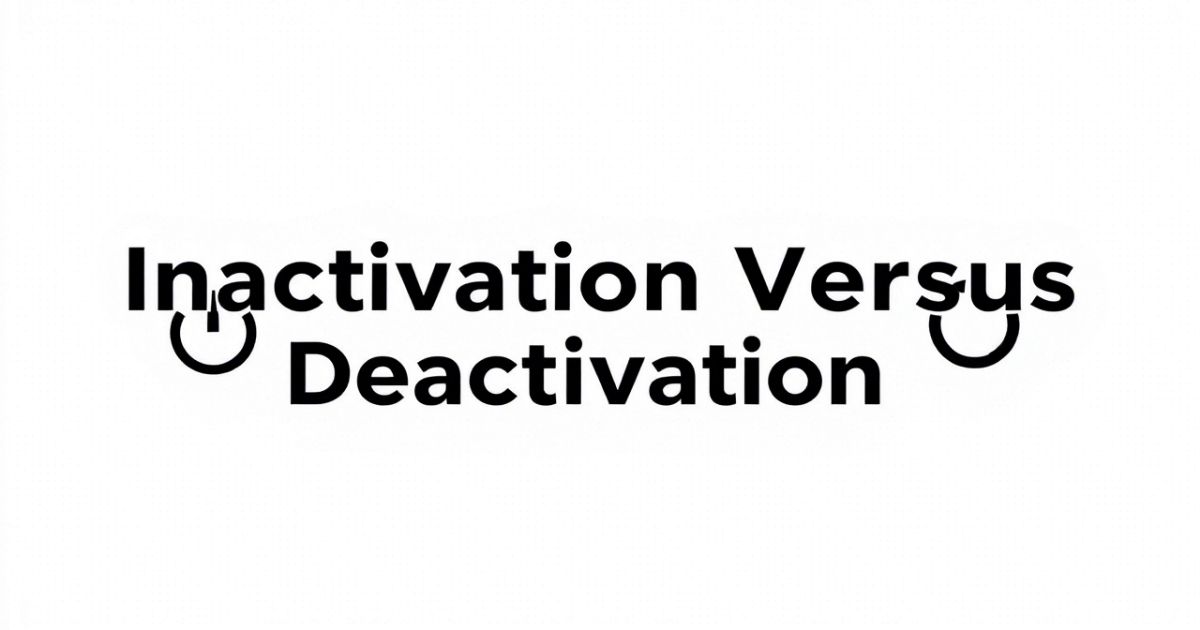What’s the difference between Inactivation Vs Deactivation? They sound alike, but they aren’t the same! Many people ask, “inactivate vs deactivate”, which one is right? The answer depends on what’s being stopped. Deactivate vs inactivate both mean to shut something down, but in different ways. A machine is deactivated when turned off, but a virus is inactivated when it loses its ability to spread.
So, should you say “inactivate or deactivate”? It depends! A drug gets inactivated, but a security system is deactivated. The terms inactivated vs deactivated are used carefully in science and technology. Experts debate “deactivate or inactivate” in fields like chemistry, medicine, and electronics. Inactivation changes structure, while deactivation stops a function. Knowing the difference between Inactivation Vs Deactivation is key in research, safety, and daily life!
Similar Meanings
Inactivation and deactivation are two terms often used interchangeably, suggesting the cessation or termination of a particular process, function, or state.
While these terms may appear to have identical meanings, a closer examination reveals subtle distinctions in their usage and connotations within specific contexts. Inactivation Vs Deactivation is an important topic in various fields, including science, medicine, and technology.
In general, both inactivation and deactivation refer to the act of rendering something inactive or non-functional. This could apply to various domains, such as technology, biology, chemistry, or even social systems. For example, in chemistry, a catalyst may undergo inactivation, meaning it no longer facilitates reactions. In contrast, a device like a security system can be deactivated, meaning it is temporarily turned off but can be reactivated when needed.
In biology, the difference between inactivation Vs deactivation is also significant. Enzymes may become inactivated due to temperature changes or inhibitors, making them ineffective in biochemical reactions. However, a biological signal, such as a nerve impulse, may be deactivated to stop further transmission temporarily. This distinction is crucial in medical and pharmaceutical sciences, where drug metabolism plays a key role in determining whether a drug becomes inactivated in the body or remains active for a longer duration.
Technology and electronics also showcase differences between inactivation Vs deactivation. A semiconductor can be inactivated through structural alterations, permanently stopping its function. Meanwhile, an electronic circuit may be deactivated, pausing its operation but allowing it to resume when necessary. These terms help differentiate between temporary and permanent states of non-functionality.
In nuclear science, deactivation refers to stopping a process, such as shutting down a nuclear reactor, while inactivation can mean neutralizing radioactive substances through transmutation. The correct usage of these terms ensures clarity in communication, particularly in scientific research and industrial applications.
Ultimately, both words imply stopping or reducing function, but their meaning changes based on the field of study. Whether discussing chemical reactions, biological processes, or technological systems, understanding the correct context for inactivation and deactivation ensures accurate descriptions and precise communication.
The Origins
Inactivation and deactivation are terms rooted in science, technology, and everyday language, each evolving to describe different processes of stopping or reducing function.
The origins of these words stem from Latin roots. “Deactivate” comes from de- (meaning “down” or “away”) and activate (meaning “to make active”). It suggests turning off or disabling something temporarily. “Inactivate” comes from in- (meaning “not”) and activate, indicating a more permanent loss of function. These distinctions shape how we use Inactivation Vs Deactivation across different fields.
In science, the concept of inactivation emerged from biology and chemistry. Enzymes, viruses, and proteins can be inactivated by heat, chemicals, or mutations. This means their function is lost permanently. Deactivation, however, became widely used in physics and engineering, referring to stopping an operation without altering the structure. A machine is deactivated when turned off but can be restarted.
In military history, deactivation has been used to describe shutting down bases, ending missions, or retiring units. The term suggests discontinuation but not destruction. In contrast, inactivation is common in medical and pharmaceutical sciences. Vaccines, for example, use inactivated viruses that can no longer replicate but still trigger immunity.
Electronics and industrial chemistry also highlight the difference. A semiconductor is deactivated by cutting power, while certain chemical processes inactivate harmful substances, making them non-reactive. This distinction is vital in safety protocols, manufacturing, and material sciences.
Understanding Inactivation Vs Deactivation clarifies their roles in science, technology, and daily life. Whether discussing inactivated vs deactivated substances or asking inactivate or deactivate, these terms carry precise meanings. From industrial applications to medical advancements, knowing whether to use deactivate or inactivate ensures proper communication in various disciplines.
The Science behind Inactivation

Inactivation is a process where something loses its ability to function, often permanently. It plays a crucial role in biology, chemistry, medicine, and industrial processes. The concept applies to enzymes, viruses, chemical reactions, and even electronic systems. Scientists carefully study inactivation to understand its effects in various fields.
In biochemistry, enzymes become inactive due to temperature changes, pH shifts, inhibitors, or structural modifications. When an enzyme is inactivated, it can no longer speed up biochemical reactions. This process is important in drug metabolism, where certain substances must be inactivated to prevent harmful effects. Similarly, in pharmaceutical science, drugs are designed to become inactivated after serving their purpose, ensuring they don’t linger in the body too long.
In microbiology, inactivation prevents the spread of viruses and bacteria. A virus is considered inactivated when it loses its ability to infect cells. This is achieved through heat, radiation, or chemical treatments. Vaccines often use inactivated viruses to trigger immunity without causing illness. Understanding inactivation vs deactivation is crucial in developing effective medical treatments and vaccines.
In chemistry, inactivation refers to the loss of reactivity in a substance. This can happen through oxidation-reduction reactions, structural changes, or the accumulation of byproducts. In nuclear science, radioactive materials undergo inactivation to reduce their harmful effects. The stability of nuclear materials depends on controlling their radioactive decay and transmutation.
Electronics and industrial chemistry also rely on inactivation. In semiconductors, materials must be carefully inactivated to prevent unwanted electrical conductivity. In industrial processes, chemicals are inactivated to stop unwanted side reactions. The concept of inactivated vs deactivated is essential when designing safe and efficient systems.
Unlike deactivation, which often refers to temporary shutdowns, inactivation usually implies a more permanent change. The ability to inactivate or deactivate a substance, system, or organism depends on the context and purpose. Whether in medicine, technology, or chemistry, the science behind inactivation helps ensure safety and efficiency.
1. Nature of Action
– Inactivation involves altering the structure or composition of something, making it permanently non-functional.
– Deactivation refers to turning something off or suspending its function without changing its structure.
– Inactivation is commonly used in biological and chemical processes, while deactivation is often used in technology and mechanical systems.
2. Duration
– Inactivation can be temporary or permanent, depending on the context.
– Deactivation can also be temporary or permanent, but it typically implies a temporary state.
– Biological inactivation, such as enzyme denaturation, is often irreversible, whereas deactivating a machine or system usually allows reactivation later.
3. Reversibility
– Inactivation is usually irreversible, as it alters the fundamental properties of the subject.
– Deactivation is often reversible, meaning the function can be restored without structural changes.
– A deactivated device can be reactivated, but an inactivated virus remains non-functional permanently.
4. Purpose
– Inactivation permanently stops a process by altering its structure or function.
– Deactivation temporarily halts a process, allowing it to restart later.
– Inactivation is common in biological and chemical processes, while deactivation is used in electronics, security systems, and machinery.
5. Examples
– Enzymes become inactivated when exposed to extreme temperatures.
– A nuclear reactor is deactivated for maintenance but can be restarted.
– Vaccines use inactivated viruses to prevent infections.
6. Impact
– Inactivation leads to irreversible loss of function.
– Deactivation allows controlled pauses without permanent damage.
– Inactivation affects biological and chemical stability, while deactivation influences operational efficiency.
7. Method
– Inactivation occurs through structural changes, such as heat, chemicals, or radiation.
– Deactivation happens by turning off or disabling a function without altering its structure.
– Enzymes are inactivated by denaturation, while electronic circuits are deactivated by cutting power.
8. Consequences
– Inactivation leads to permanent loss of function, making recovery impossible.
– Deactivation only pauses function and can be reversed.
– Inactivation affects biological and chemical systems, while deactivation impacts technology and mechanical operations.
9. Application
– Inactivation is used in medicine, chemistry, and biology to stop harmful activity permanently.
– Deactivation applies to technology, security systems, and machinery for temporary function control.
– Vaccines contain inactivated viruses, while deactivated security systems can be reactivated.
10. Scope
– Inactivation is mainly seen in biochemical reactions, pharmaceuticals, and industrial processes.
– Deactivation is broader, covering electronics, nuclear science, and mechanical systems.
– Both concepts play vital roles in science, medicine, and technology, ensuring safety and efficiency.
11. Process
– Inactivation involves altering a substance or system at a structural or molecular level.
– Deactivation works by shutting down or disabling a function without physical alteration.
– Inactivation in pharmaceuticals changes drug properties, while deactivation in electronics cuts power supply.
12. Reusability
– Inactivated substances often cannot regain function once altered.
– Deactivated systems can be reactivated when needed.
– A deactivated machine can restart, but an inactivated enzyme remains non-functional.
13. Scientific Relevance
– Inactivation is crucial in microbiology, drug development, and food preservation.
– Deactivation plays a key role in engineering, physics, and security systems.
– Both terms are widely studied in scientific fields to control functions.
14. Control Mechanism
– Inactivation requires external agents like chemicals, heat, or radiation.
– Deactivation is controlled through manual intervention or automated systems.
– A deactivated engine stops running, while an inactivated toxin loses its harmful effects.
15. Practical Use
– Inactivation ensures safety by neutralizing harmful elements permanently.
– Deactivation is useful for temporarily stopping operations without permanent effects.
– Medical sterilization inactivates bacteria, while software deactivation prevents unauthorized use.
16. Stability
– Inactivation leads to a stable, non-functional state.
– Deactivation maintains potential reactivation under suitable conditions.
– A virus inactivated by heat is permanently harmless, while a deactivated alarm can be reactivated.
17. Energy Dependency
– Inactivation often results from biochemical or chemical changes requiring no further energy input.
– Deactivation may rely on energy control, such as switching off a circuit.
– A deactivated light turns off, but an inactivated enzyme is chemically altered.
18. Industry Usage
– Inactivation is common in pharmaceuticals, microbiology, and food processing.
– Deactivation is widely used in engineering, electronics, and security.
– Factories inactivate bacteria in food production, while military devices undergo deactivation for safety.
19. Effectiveness
– Inactivation ensures a complete, often irreversible loss of function.
– Deactivation is effective but usually temporary.
– A deactivated security system can restart, while an inactivated vaccine remains non-infectious.
20. Automation
– Inactivation processes are typically manual or chemical-based.
– Deactivation can be automated through software or mechanical controls.
– A chemical inactivates a virus, while an automated system deactivates machinery.
Related Guide:
My Personal 30 Ways To Respond To A Pity Invite [2025]
The Structure Of Deactivation
Deactivation follows a specific process depending on the system involved. It often involves stopping a function without altering the core structure. In technology, deactivation disables features or shuts down operations. In chemistry, it reduces reactivity without changing the molecular structure. Inactivation Vs Deactivation differs because deactivation pauses a function, while inactivation causes a complete loss of activity.
The structure of deactivation varies across fields like electronics, medicine, and industry. It can be manual, automated, or chemically induced. A device is deactivated when turned off, but an enzyme is inactivated through structural changes. Inactivation Vs Deactivation matters in scientific research, where precise terminology ensures accuracy. Deactivation allows reactivation when needed, making it a reversible process in many cases. Understanding deactivation helps in fields like security, pharmacology, and nuclear science, where controlled shutdowns are essential.
1. Enzyme Deactivation in Biochemistry
Enzyme deactivation happens when an enzyme loses its ability to function due to temperature changes, pH shifts, or inhibitors. Unlike permanent inactivation, deactivation can sometimes be reversed if conditions are restored. This process plays a key role in Inactivation Vs Deactivation, as enzymes regulate biological reactions.
In medicine, enzyme deactivation is essential in drug metabolism, ensuring proper absorption and breakdown of pharmaceuticals. In food industries, deactivation controls fermentation, preventing spoilage. Industrial biotechnology also relies on enzyme deactivation to regulate production efficiency.
Understanding enzyme deactivation helps scientists manipulate biochemical reactions for research and application. Whether deactivating enzymes for drug development or preserving food, this process is crucial in biochemistry. The balance between activation and deactivation allows industries to control biological processes effectively. Recognizing Inactivation Vs Deactivation in biochemistry enhances the development of medicines, food production, and industrial applications that rely on enzyme regulation.
2. Chemical Deactivation in Chemistry
Chemical deactivation refers to stopping or reducing a substance’s reactivity while maintaining its structure. It is widely used in industrial chemistry, where controlling reactions ensures safety and efficiency. Unlike inactivation, which may involve structural breakdown, deactivation often preserves the material’s composition while rendering it non-reactive.
Catalyst deactivation is a common example, where catalysts lose effectiveness due to poisoning, sintering, or coking. In pharmaceuticals, deactivation prevents harmful chemical reactions, ensuring drug stability. Industrial processes rely on deactivation to control hazardous substances, reducing unwanted side effects.
The role of deactivation extends beyond chemistry into various applications. Whether in environmental protection, material science, or drug formulation, deactivation helps regulate chemical interactions. Inactivation Vs Deactivation plays a vital role in understanding controlled reactions. Proper management of chemical deactivation enhances safety in laboratories, manufacturing, and environmental applications. Scientists continuously develop new methods to optimize deactivation, ensuring sustainable and efficient chemical processes.
3. Electronic Deactivation in Organic Chemistry
Electronic deactivation in organic chemistry refers to the process of reducing or stopping a molecule’s reactivity by altering its electronic properties. This often involves changes in functional groups, electron-withdrawing effects, or steric hindrance. Unlike inactivation, which may completely destroy molecular function, deactivation can be controlled and reversed under specific conditions.
For example, in drug metabolism, deactivation modifies a compound’s structure to make it less active or easier to excrete. In catalysis, electronic deactivation occurs when catalyst sites lose efficiency due to poisoning or chemical buildup. This process plays a crucial role in industrial chemistry, where controlled deactivation helps manage reactions safely.
The concept of Inactivation Vs Deactivation is essential in organic chemistry, especially in pharmaceutical science, material synthesis, and industrial processes. Understanding electronic deactivation allows chemists to manipulate chemical behavior, improve drug formulations, and enhance reaction selectivity in various fields of study.
4. Deactivation in Electronics and Semiconductors
Deactivation in electronics and semiconductors refers to stopping or reducing the function of electronic components by controlling current flow, altering material properties, or degrading semiconductor performance. Unlike mechanical shutdowns, electronic deactivation involves manipulating electric charges, circuits, or materials at the atomic level.
For example, semiconductor deactivation occurs when impurities or overheating reduce a transistor’s efficiency, leading to device failure. In circuit design, controlled deactivation ensures that specific components stop functioning when needed, such as in power-saving modes. In industrial processes, semiconductor deactivation helps regulate electrical behavior for improved efficiency.
Understanding Inactivation Vs Deactivation in electronics is crucial for advancing technology. Whether managing semiconductor performance, designing fail-safe circuits, or improving electronic stability, deactivation plays a key role in modern engineering. Scientists and engineers continuously develop new methods to optimize deactivation, ensuring reliable and energy-efficient electronic systems.
5. Biological Deactivation in Medicine
Biological deactivation in medicine refers to stopping or reducing the activity of biological agents, such as enzymes, viruses, or drugs, to prevent unwanted effects. This process is essential in drug metabolism, where the body inactivates vs deactivates medications to ensure proper elimination.
For example, the liver deactivates drugs by modifying their chemical structure, making them less active. Enzyme deactivation prevents excessive biochemical reactions, maintaining balance in the body. Similarly, vaccines use inactivated viruses to trigger immunity without causing disease.
Understanding Inactivation Vs Deactivation in medicine helps scientists develop safer drugs, effective treatments, and better disease control methods. Controlled deactivation ensures that medications work properly and do not cause prolonged effects. This concept is vital in pharmacology, toxicology, and medical research, contributing to patient safety and therapeutic advancements.
6. Nuclear Deactivation in Physics
Nuclear deactivation involves making radioactive substances less hazardous. This can be achieved through decay processes or transmutation, where one element is transformed into another with a more stable configuration.
Managing nuclear waste and ensuring the safety of nuclear materials are key aspects of Inactivation Vs Deactivation. Scientists use shielding, cooling, and controlled reactions to deactivate or inactivate unstable isotopes, preventing radiation hazards. In nuclear reactors, deactivation stops chain reactions to ensure safe shutdowns.
The mechanics of Inactivation Vs Deactivation play a pivotal role in scientific disciplines. Whether in biochemistry, chemistry, electronics, medicine, or physics, understanding and controlling deactivation processes are essential for advancing knowledge, technological innovations, and practical applications in numerous fields.
7. Drug Deactivation in Pharmacology
Drug deactivation in pharmacology refers to the process of reducing or stopping a drug’s effectiveness in the body. This is essential to prevent excessive drug activity and potential toxicity. The liver plays a crucial role by metabolizing drugs into inactive compounds that can be safely eliminated.
For example, certain medications undergo Inactivation Vs Deactivation by enzymes before they reach the bloodstream, limiting their effects. Drug resistance can also occur when the body adapts and processes medications more quickly over time. This is a key factor in antibiotic resistance and painkiller tolerance.
Understanding Inactivation Vs Deactivation helps in designing proper dosage regimens and improving medication safety. Pharmacologists study how different drugs are metabolized to enhance their effectiveness while minimizing side effects. Controlled deactivation ensures that medications work efficiently and leave the body without causing harm.
8. Environmental Deactivation in Industrial Processes

Environmental deactivation in industrial processes focuses on neutralizing harmful substances to reduce pollution and ecological damage. Factories and industries use chemical treatments, filtration systems, and controlled reactions to deactivate toxic waste before releasing it into the environment. Proper Inactivation Vs Deactivation methods help industries meet safety standards and prevent long-term environmental harm.
For instance, catalytic converters in vehicles deactivate harmful emissions like carbon monoxide, transforming them into less dangerous gases. In wastewater treatment plants, chemical Inactivation Vs Deactivation neutralizes pollutants, making water safe for reuse or disposal.
Proper deactivation techniques ensure environmental sustainability and regulatory compliance. Scientists and engineers continuously develop new methods to improve industrial waste management and minimize environmental impact. Effective deactivation strategies protect ecosystems and public health while promoting sustainable industrial practices.
9. Circuit Deactivation in Electrical Engineering
Circuit deactivation in electrical engineering involves stopping the flow of electricity in a circuit to prevent overheating, short circuits, or damage to components. This is done through switches, breakers, or automated safety mechanisms.
For example, circuit breakers deactivate power when a surge occurs, protecting appliances from damage. In semiconductors, deactivation controls the operation of transistors, regulating power distribution in electronic devices. Temporary deactivation is common in maintenance work, ensuring safety during repairs.
Understanding how circuits are deactivated is crucial in designing reliable electrical systems. Engineers use controlled deactivation to optimize power consumption, prevent failures, and enhance device performance. This concept is widely applied in consumer electronics, industrial machinery, and power grids.
10. Immune System Deactivation in Biology
Immune system deactivation is a natural process that prevents excessive immune responses, reducing the risk of autoimmune diseases. When an immune reaction is no longer needed, regulatory cells signal the immune system to deactivate, preventing unnecessary inflammation.
For instance, after fighting an infection, the immune system deactivates antibodies and immune cells to restore balance. Medical treatments like immunosuppressants help deactivate immune responses in organ transplants to prevent rejection.
Proper immune deactivation is vital for overall health. If the process fails, it can lead to chronic inflammation or autoimmune disorders. Scientists study immune deactivation to develop treatments for allergies, autoimmune diseases, and immune-related conditions.
Examples starting with prefix (de)
- Deactivate – Security systems deactivate when power is turned off, preventing unauthorized access and ensuring safety.
- Decompose – Organic waste decompose naturally, breaking down into simpler substances that enrich soil and support plant growth.
- Decontaminate – Hospitals decontaminate medical equipment to eliminate harmful bacteria and viruses, ensuring patient safety.
- Dehydrate – Fruits dehydrate when exposed to heat, preserving them for long-term storage while concentrating their natural flavors.
- Declassify – Governments declassify documents after a period, making previously restricted information available to the public.
- Deflate – Balloons deflate when punctured, losing air and collapsing into their original, uninflated shape.
- Demagnetize – Electronic devices demagnetize old tapes, erasing data and preventing accidental retrieval.
- Decelerate – Vehicles decelerate when approaching traffic signals, ensuring safe stops and preventing accidents.
- Defrost – Frozen foods defrost when left at room temperature, making them ready for cooking or consumption.
- Deform – Heat can deform plastic, changing its shape permanently due to molecular rearrangement.
- Derail – Strong winds derail trains, causing severe disruptions and potential accidents.
- Devalue – Economic instability can devalue a country’s currency, reducing its purchasing power internationally.
- Deconstruct – Architects deconstruct old buildings to analyze and reuse valuable materials.
- Deprogram – Cult specialists deprogram individuals, helping them regain independent thought after indoctrination.
- Depopulate – Wars and pandemics depopulate cities, leaving vast areas abandoned.
- Dethrone – Political revolutions dethrone monarchs, replacing them with democratic governance.
- Depressurize – Airplanes depressurize at high altitudes, requiring oxygen masks for passenger safety.
- Delegitimize – False accusations delegitimize leaders, damaging reputations and credibility.
- Decontaminate – Scientists decontaminate hazardous sites, ensuring safe environmental conditions.
- Decompress – Deep-sea divers decompress slowly to prevent nitrogen-related injuries.
- Decaffeinate – Manufacturers decaffeinate coffee beans to produce caffeine-free beverages.
- De-escalate – Peace talks de-escalate conflicts, reducing violence and tension.
- Decompose – Dead organisms decompose over time, contributing nutrients to ecosystems.
- Defame – False reports defame celebrities, harming their public image.
- Depict – Paintings depict historical events, preserving cultural heritage.
- Deplete – Overfishing depletes ocean resources, endangering marine life.
- Desensitize – Repeated exposure desensitizes people to violence, altering emotional responses.
- Decipher – Cryptographers decipher secret codes, uncovering hidden messages.
- Decommission – Old power plants decommission outdated machinery, ensuring safety.
- Defer – Students defer loan payments, postponing financial obligations.
Words created by adding “in ” to a verb, along with their meanings

- Inactivate – Scientists inactivate viruses to prevent infections and create vaccines for public health safety.
- Inhabit – Wild animals inhabit dense forests, making them their natural homes and thriving in diverse ecosystems.
- Include – The menu includes vegetarian options, catering to different dietary preferences for customers.
- Increase – Exercise increases endurance, strengthening muscles and improving cardiovascular health over time.
- Influence – Teachers influence students by shaping their knowledge, behavior, and future career choices.
- Inspire – Great leaders inspire people to achieve success by motivating them through words and actions.
- Indicate – Road signs indicate directions, ensuring smooth and safe travel for drivers.
- Inject – Doctors inject vaccines into patients, helping build immunity against dangerous diseases.
- Inspect – Officials inspect factories to ensure compliance with safety and environmental regulations.
- Inform – News channels inform the public about important events happening worldwide.
- Initiate – Companies initiate projects to develop innovative solutions for emerging market needs.
- Install – Technicians install security systems to protect buildings from unauthorized access.
- Inscribe – Ancient civilizations inscribe messages on stone tablets to preserve history.
- Invest – Smart investors invest in stocks to grow their wealth over time.
- Invite – Friends invite each other to parties, strengthening their social bonds.
- Inspect – Engineers inspect bridges regularly to prevent structural failures.
- Inhale – People inhale fresh air in parks, benefiting their respiratory health.
- Interpret – Historians interpret old manuscripts to understand past cultures.
- Intervene – Mediators intervene in disputes to resolve conflicts peacefully.
- Intrude – Strangers intrude into private property, violating personal space.
- Insult – Rude remarks insult people, hurting their feelings and dignity.
- Incur – Late payments incur additional fees, increasing financial burdens.
- Invent – Scientists invent new technologies, improving human life.
- Impose – Governments impose taxes to fund public services and infrastructure.
- Induce – Certain drugs induce sleep, helping with insomnia treatment.
- Imitate – Children imitate parents, learning habits and behaviors from them.
- Include – Event organizers include entertainment to attract attendees.
- Inflict – Wars inflict suffering, causing loss of lives and homes.
- Implant – Surgeons implant medical devices to restore bodily functions.
- Immerse – Travelers immerse themselves in different cultures to gain new perspectives.
FAQ’s
What is the difference between inactivation and deactivation in the Army?
In the Army, Inactivation Vs Deactivation refers to different statuses. Inactivation temporarily removes a unit, while deactivation permanently disbands it, ending all operations officially.
What is the difference between deactivate and reactivate?
Deactivate is the correct term, meaning to turn something off. “Deactivate” is not commonly used. Inactivation Vs Deactivation both involve stopping function, but context matters.
What does deactivation mean?
Deactivation means stopping an operation or function. Inactivation Vs Deactivation differs, as inactivation prevents future use, while deactivation stops something temporarily or permanently.
Which is correct, inactive or deactivated?
Deactivate is an action, while inactive is a state. Inactivation Vs Deactivation means something was either turned off (deactivated) or made permanently ineffective (inactivated).
What is the difference between activation and deactivation?
Activation starts a process, while deactivation stops it. Inactivation Vs Deactivation means something is either permanently altered (inactivated) or temporarily stopped (deactivated).
Conclusion
Understanding Inactivation Vs Deactivation is important in many fields. The words may seem similar, but they are not the same. Inactivate vs deactivate depends on the situation. Machines and devices get deactivated, while chemicals and viruses get inactivated. If something loses its function temporarily, it is usually deactivated. If it can never work again, it is inactivated.
So, should you say “inactivate or deactivate”? It depends on what you mean. A drug can be inactivated, but a security system is deactivated. The terms inactivated vs deactivated are used carefully in science, medicine, and technology. Deactivate vs inactivate may seem interchangeable, but they are not. Experts think about “deactivate or inactivate” when studying reactions and processes. Knowing Inactivation Vs Deactivation helps in research, industry, and everyday life. Using the right word makes communication clear and accurate.

Zion Blaze is a dedicated administrator with 5 years of experience in managing operations, optimizing workflows, and ensuring efficiency. Skilled in leadership, problem-solving, and team coordination.

